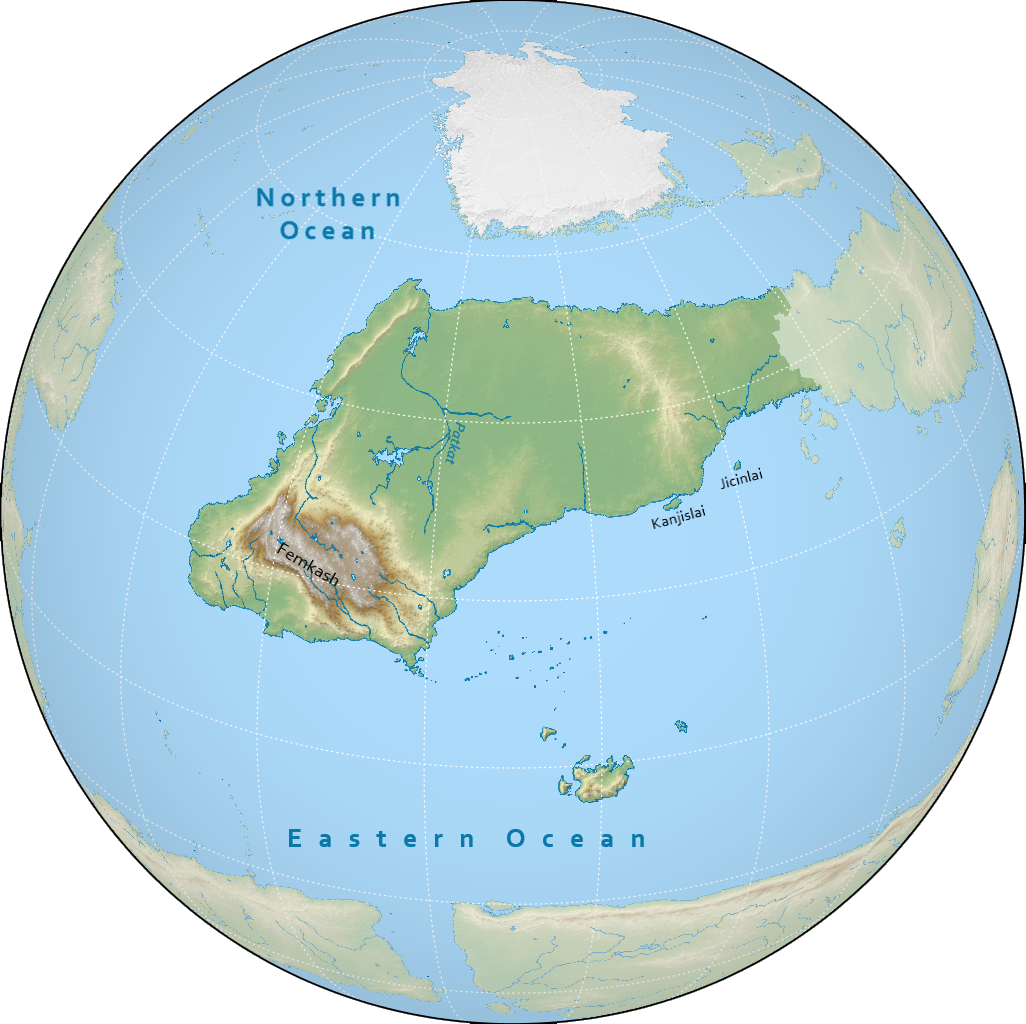name
the name of vazeheyi comes from waptokan 'pòtek aiakai žy', meaning "land of sunrise", owing to its easterly location from yafu.
geography
vazeheyi is the third smallest continent on notasami at 22 million square kilometres. it is surrounded by the northern ocean to the northwest and the eastern ocean to the southeast. the border between western and eastern vazeheyi, if eastern vazeheyi is considered part of nefriheyi, roughly follows the 130th meridian east.
climate
the climate of vazeheyi is mostly subtropical.
the southern coast of vazeheyi is tropical, but further inland lie the femkaš highlands, which introduce various alpine climates.
the north coast is mostly temperate, save for a semi-arid band in the centre.
on the border with nefriheyi the climate becomes very arid.
countries & territories
| flag | name | population | area |
|---|---|---|---|
| patkatyi | 635,164,502 | 910,098 km² | |
| (tbd) | - | - |
history
the history of vazeheyi is usually divided into the following periods:
- prehistory: before -750
- bronze age: -750 to 100
- classical period: 100 to 600
- postclassical period: 600 to 1688
- early modern period: 1688 to 2050
- modern period: 2050 to 2300
- interstellar period: 2300 to present
agriculture is believed to have originated in the south and spreading northwards, which was dominated by nomadic pastroralists.
the first major civilisation was latsqaan, which would become a major centre of trade. this newfound wealth would then lead it to propagate much of its culture and customs throughout the various trade routes it intersected.
in this period, latsqaan is first conquered, and several kingdoms emerge across the continent, decentralising trade. many of these kingdoms, having adopted many aspects of latsqaanian culture, start to culturally diverge and evolve into their own unique branch of traditions which remain the basis of many modern day cultures. this period also sees the rise and fall of several influential hegemons such as the lêtsěn̂ empire, the zäldëns, and the šom kingdom.
this period sees rampant fragmentation and a rise in instability as several polities gradually collapse into several smaller ones. in the 12th century a wave of migrations commences from femkaš, the southern plateau, dramatically changing the political and cultural landscape especially in the east. the instability of the north meant that migrating southerners had a chance to gain a foothold in certain places, and while many kishefdu cultures were influenced by northern cultures, many still kept and took with them their indigenous customs, strongly influencing much of the continent.
this period sees southern vazeheyi dominated under powers from emiheg, namely gutonim and the countries of yafu. the northeastern third of the continent is however less affected.
this age sees the colonies of vazeheyi gain independence from the empires of emiheg, some through struggle, and some peacefully.
this recently-defined period starts with the discovery of interstellar travel and examines the role of the countries of vazeheyi in the now accessible interstellar domain.
demographics
languages
many different language families and language isolates can be found on vazeheyi. it is estimated that there are some 650 different languages spoken across the continent. there are three main genealogical groups of languages; from west to east these are, the šalolan languages, the teca-kanjisadan family to which tangachi, the largest language on notasami belongs, and the tajisenian family. the languages of femkaš to the south are often grouped together on a purely geographical basis.
religion
vazeheyi is divided into east-west halves when it comes to the major religions in the area. the east is dominated by keridism, while the west is predominantly calga. more specifically, the southeast, that is in and around femkaš, mostly adheres to forist keridism, and the far west follows lonca lishexa calga.
apart from these, several minority religions are also practiced, from ones native to vazeheyi like otxolitsi to ones brought over by colonialism like bunapunism.
population
the most populous country in vazeheyi is patkatyi with over 635 million people. it is also the most populous country on notasami. almost all countries in vazeheyi have populations over 1 million people, and six countries have more than 100 million people.
the largest metropolitan areas in vazeheyi include lahkanta, alen, and kotripten. the three of these have populations exceeding 20 million people, and fifteen more have more than 10 million people, making them megacities.
